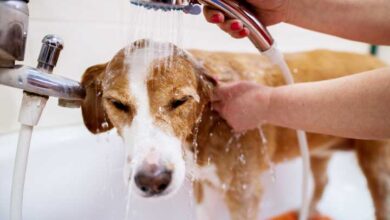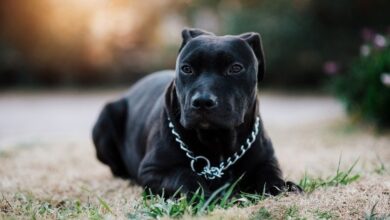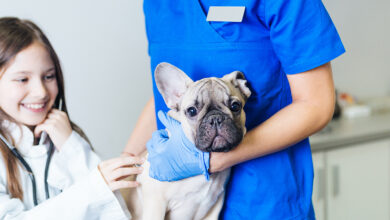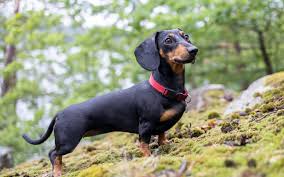Cattle Dog: The Ultimate Guide To The Australian Cattle Dog
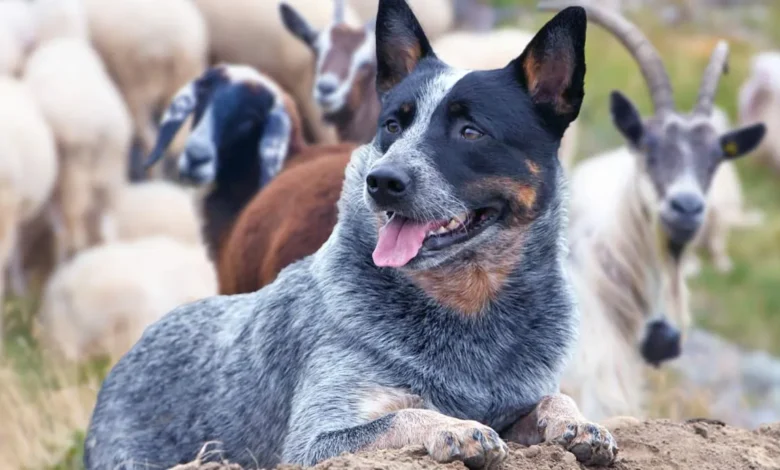
FAQs About Australian Cattle Dog
Are Australian Cattle Dogs Friendly?
Australian cattle dogs are versatile family companions that bond strongly with their humans. When properly socialized, the majority are friendly towards people of all ages, including children. However, there are a few qualifying notes:
- Early socialization before 16 weeks is key to ensuring friendly interactions as an adult. Unsocialized dogs may be wary.
- Cattle dogs are working breeds with herding instincts. Untrained, they may nip to control overstimulated children or try “herding” by circling.
- Their protective nature means well-socialized dogs still discriminate between familiar friends versus strangers and alert their people to potential “threats.”
- Like any breed, some individual dogs simply have stronger instincts and may not suit homes with small kids full-time without cautious introduction and supervision.
Overall, when raised with consistent positive training, Australian cattle dogs thrive as affectionate family members and bond strongly with their people. However, responsible owners still take precautions, introducing them to new situations and watching for signs of overstimulation. With the right match, they make wonderful family dogs.
Are Australian Cattle Dogs Good?
When it comes to being family pets and companions, Australian cattle dogs receive praise for their devoted nature, intelligence, and funny personalities. Here’s an overview of why they can make excellent dogs:
- Trainability – As a highly intelligent breed, cattle dogs thrive on learning and appreciate structured activity. Positive reinforcement training helps redirect their energy in a productive way.
- Loyalty – They form powerful bonds with their owners and families. Expect an eager shadow who wants to be wherever the action is.
- Work ethic – Cattle dogs enjoy challenges, tasks, and games that engage their minds. This drive makes them suitable for dog sports or job opportunities like therapy or search and rescue work.
- Adaptability – If raised with exposure to various settings and people, they settle into most lifestyles, from active farms to city apartments, depending on their individual exercise needs to be met.
- Humor – They have lively, playful sides and keep owners entertained with expressive personalities and antics.
However, prospective owners must also consider:
- Energy levels – Sedentary homes may struggle to wear out a working breed prone to boredom and destructive habits without sufficient activity.
- Herding instincts – If left unleashed, they may try circling or nipping at heels to move “flocks.” Socialization helps curb this.
- Independence – They can learn to be aloof towards strangers and think for themselves, challenging less experienced handlers.
With patience and adaptive management of needs, Australian cattle dogs forge tight family bonds and satisfy active companions. Their good nature shines through challenges when given consistent boundaries, exercise, and mental stimulation as a working breed. The right home brings out the very best in this devoted dog.
Are Australian Cattle Dogs Very Smart?
Yes, Australian cattle dogs are considered one of the most intelligent breeds. Here’s a closer look at their mental capabilities:
- Trainability – They catch onto basic commands swiftly and enjoy learning new tricks/tasks throughout life. Consistency yields quick results.
- Problem-solving – Cattle dogs naturally assess situations and independently reason solutions to obstacles or problems at hand when herding.
- Adaptability – With experience and training exposure, they learn new routines, surroundings, and people skillfully.
- Focus – These dogs pay sharp attention when engrossed in activities, commands, or herding scenarios, easily understanding human cues and expectations.
- Memory – Cattle dogs memorize terrain and behaviors and have been reported greeting strangers by name years after previous introduction.
- Independence – Their independent thinking also requires owners to provide strong, consistent leadership and boundaries to keep high-IQ antics constructive.
Numerous tests and studies place Australian herding breeds like cattle dogs in the top 10 most intelligent canine categories based on problem-solving skills, trainability, and adaptability. Coupled with high energy, this demands ample daily mental and physical exercise for a well-balanced pet. Their keen minds make impressions for life.
Do Australian Cattle Dogs Talk?
While Australian cattle dogs don’t vocally “talk” like parrots, they do communicate needs and emotions through diverse vocal sounds:
- Barking – Serves as an alert or alarm sound when strangers approach. Excessive, unwanted barking needs training to curb.
- Whining – A quieter vocalization used for seeking attention, play, or to express mild discomfort.
- Yelping – An excited, high-pitched bark or cry emitted during spirited play or startled reactions.
- Growling – A warning from the throat indicating the dog feels threatened or needs space from something unwelcome.
- Grunting/snorting – Soft snuffles that signal contentment, focus, acknowledgment, or encouragement when herding livestock.
- Sighing/groaning – Relaxed exhales to show boredom, relaxation, or settling in for rest after activity.
So while their vocabulary is simple compared to parrots, cattle dogs demonstrate various emotive noises to communicate non-verbally with humans and each other depending on circumstances. Understanding each helps build a stronger relationship.
Do Australian Cattle Dogs Bark A Lot?
Some key points on Australian cattle dog vocal tendencies:
- As alert watchdogs bred for ranging farmland, a certain amount of barking comes naturally to signal potential issues or outsiders approaching.
- Puppies tend to vocalize more as they try different sounds to communicate. Consistent training reduces unwanted barking as adults.
- Well-socialized dogs may bark less at familiar people/sights but stay vocal, alerting to true strangers or potential problems.
- Under-exercised or bored dogs lacking stimulation release pent-up energy through more barking out of restlessness instead of purpose.
- Individual personality and environment affect volume. Rural/working dogs may bark more frequently than pets in companion homes.
A Hard-Working Herding Breed With Humor and Heart cattle dog
The Australian cattle dog, also known as the Australian heeler or Queensland heeler, is a medium-sized herding breed bred in Australia for droving cattle over long distances in difficult terrain in all weather conditions. They are energetic, intelligent, active companions that thrive on mental and physical challenges and jobs to do. But beneath their tough working spirit lies humor, affection, and loyalty that have made them popular pets and beloved companions around the world.
Australian Cattle Dog Lifespan
Australian cattle dogs have a typical lifespan of 12-15 years when well cared for. With responsible ownership that includes good nutrition, regular exercise, and veterinary care, many Australian cattle dogs live to 14 years or older. This is comparable to other medium-sized dog breeds. Of course, individual lifespans can vary based on genetics, lifestyle factors, and medical history. Some key steps owners can take to support their Australian cattle dog’s longevity include spaying or neutering, maintaining a healthy weight, daily exercise and play, high-quality pet insurance, and regular wellness exams with their veterinarian.
Australian Cattle Dog Size and Weight
Average Sizes
Australian cattle dogs come in two distinct varieties – the smaller “straight coat” variety and the larger “rough coat” variety. On average:
- Straight coat Australian cattle dogs stand 17-20 inches tall at the shoulder and weigh 25-40 pounds.
- Rough coat Australian cattle dogs stand 18-22 inches tall at the shoulder and weigh 30-45 pounds.
Weight Guidelines
It’s important to keep Australian cattle dogs at a healthy weight. Being even a few pounds overweight can increase stress on joints and organs over their lifetime. For guidance on ideal weight ranges, consult a vet. In general:
- Males weigh 30-45 lbs.
- Females weigh 25-40 lbs.
Their size and weight make them agile, hardy workers who can move cattle all day in rugged conditions yet still be manageable pets. Proper nutrition and regular exercise as puppies and into adulthood help them maintain a slender, athletic silhouette suited to their active herding lifestyle.
Australian Cattle Dog Price
When seeking to purchase an Australian cattle dog from a reputable breeder, the average price range is $600-$1200, depending on the dog’s pedigree, gender, and coat variety. Top-quality puppies from champion bloodlines may cost more, while adoption through a shelter is often much less.
Additional lifetime costs to consider include vet care, supplies, training, food, and insurance. On average, the total cost of ownership for an Australian cattle dog from purchase through their lifespan is estimated between $1500-$5000, depending on location and unforeseen medical needs. Initial startup costs for an 8-week-old puppy generally total $1000-$2000, including the price of the puppy, initial vet exams/vaccines, food, crate, leash/collar, and other essential supplies.
Demand is high for well-bred Australian cattle dogs since they make wonderful family companions and farm dogs, so planning ahead and patience may be needed to find a puppy. Reputable breeders will have a waitlist and do in-home visits and interviews to ensure the right match. Adopting a pet is also a great option and saves a life.
Australian Cattle Dog Puppy
Raising an Australian cattle dog puppy requires a commitment to their training, socialization, and needs for mental and physical activity as they grow. Here are some tips for those welcoming a pup:
- Start obedience training immediately in short sessions multiple times daily. They are highly intelligent and respond best to positive reinforcement.
- Socialize the puppy extensively with people and safely expose them to different sights, sounds, and environments before 16 weeks. This creates a well-rounded adult dog.
- Consider puppy kindergarten classes to help with leash training, manners, and social skills around other pups.
- Supervise all play with children and establish yourself as pack leader from the start with consistency and fairness.
- Do not leave unattended until housetrained. Take outside regularly, use the same word/signal, and praise successes.
- Provide plenty of chew toys and mental stimulation to redirect nipping/biting as they lose puppy teeth.
- Expect an energetic, nibbling puppy! But their joyful nature and trainability make the hard work rewarding. With time and patience, wonderful companions emerge.
Australian Cattle Dog vs. Blue Heeler
While often used interchangeably, the Australian cattle dog and Australian blue heeler are two distinct breed varieties within the same ancestral type of medium-sized, multipurpose herding dog originally developed in Australia. Here are some key differences:
- Coat: Australian cattle dogs come in rough or smooth coats. Blue heelers have their trademark distinctive mottled blue or red brindle coat and white markings.
- Size: On average, Australian cattle dogs tend to be a bit larger than blue heelers at 18-22 inches tall vs. 15-18 inches tall and 30-45 lbs vs 15-30 lbs, respectively.
- Color: Australian cattle dogs can be blue or red brindle, black & tan, red or red speckled. Blue heelers are specifically blue or red brindle with white markings.
- Origin: Australian cattle dogs were developed in Queensland. Blue heelers emerged in New South Wales and Victoria at a later date.
- Temperament: Both are purposeful hard workers, but blue heelers are often described as more intense and energetic, while Australian cattle dogs also have a playful streak.
At the end of the day, temperament, drive, and health vary individually in both breeds based on breeding and environment. Either make devoted companions for active owners.
Australian Cattle Dog vs American Cattle Dog
The term “American cattle dog” commonly refers to the Australian cattle dog breed that has been incorporated into work in the United States rather than a distinct breed variety. Here are some similarities and differences:
- Ancestry: Both share the same ancestral lines originating from now-extinct European herding breeds brought to Australia in the 19th century and then later to America.
- Traits: They retain the same stocky build, herding instincts, and trainability for working livestock on large, remote ranches.
- Size: No significant size differences exist between the two types. Australian cattle dogs average 17-22 inches tall and 25-45 lbs.
- Coat: Australian-bred dogs can be rough or smooth coats. American types are predominantly smooth coats due to regional preferences.
- Color: Both demonstrate the same range of colors and patterns.
- Job: In America, they work cattle and compete in stock dog trials versus the livestock herding jobs in Australia.
So, in essence, there is no distinctive “breed” separation. Australian cattle dogs adaptably fulfill the same roles as capable cattle herders in both countries’ agricultural industries and make devoted family companions worldwide.
Australian Cattle Dog Lifespan
The average lifespan of an Australian cattle dog is 12-15 years. Some owners report that their dogs have been living up to 18 years with outstanding care. The top factors influencing a cattle dog’s longevity include:
- Genetics: Some bloodlines are predisposed to certain health issues. Reputable breeders screen for heritable diseases.
- Nutrition: A balanced diet tailored for their activity level supports organ and joint health into senior years.
- Exercise: Daily mental and physical activity stimulates blood flow and keeps weight under control.
- Veterinary care: Regular exams are conducted early for potential issues to ensure the best treatment outcomes.
- Environment: Stress factors like extreme temperatures or parasites can tax the body.
With attention to preventative healthcare, diet, and training, and an active lifestyle suited to their energy levels, Australian cattle dogs have the potential for long, vibrant lives filled with devotion to their human family and jobs.
While cattle dogs’ inner alarm bell can’t be fully silenced, responsible owners address barking through sufficient exercise, training, attention, and managing circumstances that trigger excesses. Most settle into periodic vocal alerts rather than prolonged, annoying sounds when their needs are met.
